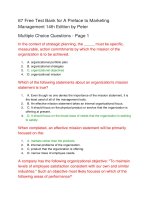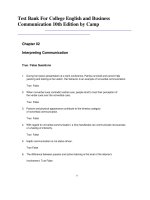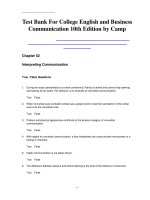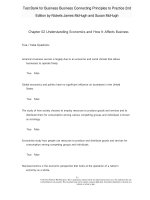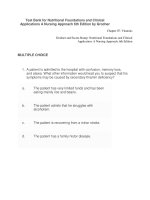Test bank for nursing interventions and clinical skills 5th edition by perry
Bạn đang xem bản rút gọn của tài liệu. Xem và tải ngay bản đầy đủ của tài liệu tại đây (44.41 KB, 6 trang )
buy this full document at
Perry: Nursing Interventions & Clinical Skills, 5th Edition
Chapter 01: Using Evidence in Practice
Test Bank
MULTIPLE CHOICE
1. A nursing educator is explaining how the best clinical practices are determined. Which
statement best explains the purpose of evidence-based practice?
A. It ensures that all patients receive holistic care.
B. It provides a definite reason for providing care in a specific manner.
C. It prevents errors when care is being delivered.
D. It guarantees that care delivered is based on research.
ANS: B
Evidence-based practice is the use of the current best evidence in making patient care
decisions. It applies to all types of health care professionals. Currently there is no method
that can ensure that all patients receive holistic care, that all errors can be prevented, or
that a guarantee exists that care given is based on research.
PTS: 1
Knowledge
DIF: 1
REF: Page 1
TOP: Cognitive Level:
2. Which question is a problem-focused trigger?
A. What is known about reduction of urinary tract infections in the older adult with
diabetes?
B. How can chronic pain best be described when the patient is nonverbal?
C. How long can an intravenous catheter remain in place in an obese patient?
D. What measures can the nurse take to reduce the rising incidence of urinary tract
infections on the elder-care unit?
ANS: D
A problem-focused trigger is a question faced when caring for a patient or a trend seen in
a practice setting. In this example there is a problem (urinary tract infections) and a trend
(on the elder-care unit). The other questions are general information questions, not based
on what is happening in a specific area or to a group of specific patients in an area or
relating to an observed trend.
PTS: 1
Knowledge
DIF: 1
REF: Page 2
TOP: Cognitive Level:
3. What does the “I” indicate in a “PICO” question?
A. Intervention of interest
B. Incorporation of concepts
C. Implementation by nursing
D. Interest of personnel
ANS: A
buy this full document at
Full file at />The “I” stands for intervention of interest, meaning what the nurse hopes to use in
practice and believes is worthwhile or valuable. This could be a treatment for a specific
type of wound or an approach on how to teach food preparation for a patient with
impaired sight.
PTS: 1
DIF: 1
TOP: Cognitive Level: Knowledge
REF: Page 2, Box 1-1
4. The nurse is conducting clinical research and needs to obtain relevant databases. Whom
should the nurse contact?
A. The physician whose patients may be involved in the study
B. The medical librarian
C. The nurse manager of the unit where the study will be conducted
D. The director of nursing of the facility
ANS: B
The medical librarian is most knowledgeable regarding databases relevant to a study. The
other individuals will know about the study but do not have the knowledge regarding
relevant databases.
PTS: 1
Knowledge
DIF: 1
REF: Page 2
TOP: Cognitive Level:
5. Which database contains clinical guidelines systematically developed for a specific set of
circumstances involving a specific patient population?
A. MEDLINE
B. CINAHL
C. Cochrane Data of Systematic Reviews
D. The National Guideline Clearinghouse
ANS: D
The National Guideline Clearinghouse is a database supported by the Agency for
Healthcare Research and Quality. It contains clinical guidelines systematically developed
about a plan of care for a specific set of clinical circumstances involving a specific
patient population. The others are not as specific and have broader application and
references.
PTS: 1
Knowledge
DIF: 1
REF: Page 3
TOP: Cognitive Level:
6. The nurse researcher is trying to determine the clearest type of research. Which type of
research would the nurse choose as the gold standard?
A. Randomized controlled trials
B. A qualitative study
C. A descriptive study
D. A case-controlled study
ANS: A
Copyright © 2012, 2008 by Mosby, Inc., an affiliate of Elsevier Inc. All rights reserved.
Full file at />Individual randomized controlled trials are the gold standard for research. This type of
study establishes cause and effect and the best way for testing a therapy or an
intervention. The other types of studies are useful but do not give the same type of
information as a randomized controlled trial provides.
PTS: 1
Knowledge
DIF: 1
REF: Page 4
TOP: Cognitive Level:
7. What is the nurse attempting to determine when critiquing the evidence?
A. If the potential study is ethical to conduct
B. If there is enough evidence to ask a PICO question and change practice
C. If there are any experts in the clinical area to be researched
D. If the study is cost-effective if a change in practice occurs
ANS: B
Once a literature search is complete and data gathered about the question, it is time to
critique the evidence. The critique tells the nurse if there is enough evidence to answer
the PICO question and change practice. The other questions are important to consider
when doing the study but are not applicable to critiquing the evidence.
PTS: 1
DIF: 1
TOP: Cognitive Level: Comprehension
REF: Page 5
8. Why is piloting a practice change after conducting a study the best approach to change?
A. It ensures that all of the patients involved will benefit from the change.
B. It helps identify any issues with implementation on a limited basis.
C. It facilitates communication among all of the participants.
D. It provides better acceptance by personnel reluctant to change.
ANS: B
Piloting a practice change involves implementing the change for a small group of patients
over a limited period of time. This allows identification of issues with the implementation
of the practice change(s) to determine if the change(s) result in beneficial patient
outcomes. If the pilot is successful, it is easier to make the changes on a larger scale
because the issues have been identified. It does not ensure that all patients involved will
benefit, nor does it facilitate communication among participants. Difficulty making and
accepting change may be experienced by some staff members, no matter how successful
the pilot.
PTS: 1
DIF: 2
TOP: Cognitive Level: Comprehension
REF: Page 6
9. A study is being conducted comparing a group of normal-weight postmenopausal women
not receiving any hormone treatment with a group of obese postmenopausal women not
receiving any hormone treatment to determine the incidence of changes in bone density
of the lower spine (L4 and below). Which type of study would this be?
A. Qualitative
B. Case-controlled
Copyright © 2012, 2008 by Mosby, Inc., an affiliate of Elsevier Inc. All rights reserved.
Full file at />C. Descriptive
D. Quality improvement
ANS: B
A case-controlled study examines one group of subjects with a certain condition at the
same time as another group of subjects who do not have the condition to determine if
there is an association between the condition and predictor variables. A qualitative study
examines individuals’ experiences with health problems and the contexts in which the
experiences occur (e.g., a group of poststroke patients and how the attitude of the
therapist affected their recovery). A descriptive study looks at specific concepts such as
health care workers’ perceptions of infection control practices. Quality improvement is
not a study but a collection of data reflecting trends and information about clinical
conditions and problems.
PTS: 1
Analysis
DIF: 2
REF: Page 4
TOP: Cognitive Level:
10. Which question would be the best example of a knowledge-focused trigger?
A. What is the best method for treatment of leg swelling when a patient is taking
gabapentin (Neurontin)?
B. How can we decrease the incidence of skin cancer in seniors over the age of 65?
C. What is the current evidence for improving oral intake for cancer patients with
stomatitis?
D. What is the maximum length of time our hospital allows irrigation kits to be used?
ANS: C
A knowledge-focused trigger is a question regarding new information about a topic. It
does not have to be concerned with what is happening on a specific unit or with a specific
group of people. The other questions are examples of problem-focused triggers in which
a patient problem exists and an approach needs to be found for improving or eliminating
the problem.
PTS: 1
Analysis
DIF: 2
REF: Page 2
TOP: Cognitive Level:
11. In which database would biomedical and pharmaceutical studies be found?
A. EMBASE
B. PsycINFO
C. MEDLINE
D. CINAHL
ANS: A
EMBASE contains biomedical and pharmaceutical studies. PsycINFO contains
psychology and related health care disciplines. MEDLINE includes studies in medicine,
nursing, dentistry, psychiatry, veterinary medicine, and allied health. CINAHL includes
studies in nursing, allied health, and biomedicine.
PTS: 1
Knowledge
DIF: 2
REF: Page 3
TOP: Cognitive Level:
Copyright © 2012, 2008 by Mosby, Inc., an affiliate of Elsevier Inc. All rights reserved.
Full file at />MULTIPLE RESPONSE
1. When collecting the best evidence, what should the nurse use as external evidence?
Select all that apply.
A. Scientific literature
B. Agency policy and procedure manuals
C. Clinical practice guidelines
D. National guidelines
E. National benchmarks
F. Quality improvement data
ANS: A, D, E
Scientific literature such as computerized bibliographical databases, national guidelines,
and national benchmarks provide external evidence. The other sources listed provide
internal evidence.
PTS: 1
Analysis
DIF: 3
REF: Page 2
TOP: Cognitive Level:
2. The nurse is conducting research on decreasing the incidence of pressure areas. Which
parts of an evidence-based article would give the nurse enough information to determine
if the article would be of help in the research? Select all that apply.
A. Design of the study
B. Narrative
C. Abstract
D. Literature review
E. Results
F. Introduction
ANS: C, F
The abstract and the introduction together provide enough information to help the nurse
know if the article will provide useful information for the PICO question being asked.
The method or design of the study explains how the research study is organized. The
narrative includes the purpose statement, methods or design, results or conclusions, and
clinical implications. The literature review helps the researcher examine past research on
the same topic. The results are embedded in the narrative and summarize the findings.
PTS: 1
Analysis
DIF: 2
REF: Page 5
TOP: Cognitive Level:
OTHER
1. Place the six steps of evidence-based practice in order.
A.
B.
C.
D.
E.
Evaluate the practice change.
Apply the evidence.
Collect the best evidence.
Ask a clinical question.
Communicate the results.
Copyright © 2012, 2008 by Mosby, Inc., an affiliate of Elsevier Inc. All rights reserved.
Full file at />F. Appraise the evidence gathered.
ANS:
D, C, F, B, A, E
Evidence-based practice begins with forming a relevant and meaningful clinical question
(i.e., formulating the “PICO” question). Next the best evidence, both internal and
external, must be collected. The evidence must be evaluated for its validity and relevance
before it can be applied. The change in practice is implemented and evaluated; then the
results are communicated.
PTS: 1
Analysis
DIF: 3
REF: Page 1
TOP: Cognitive Level:
Copyright © 2012, 2008 by Mosby, Inc., an affiliate of Elsevier Inc. All rights reserved.
